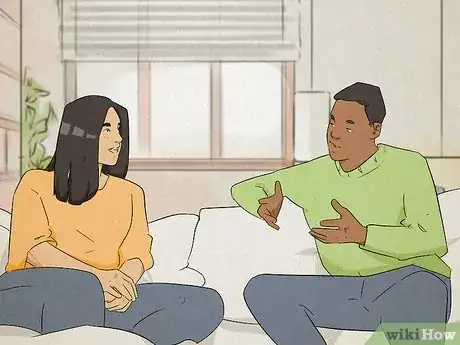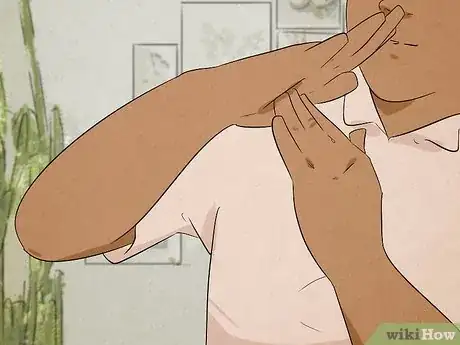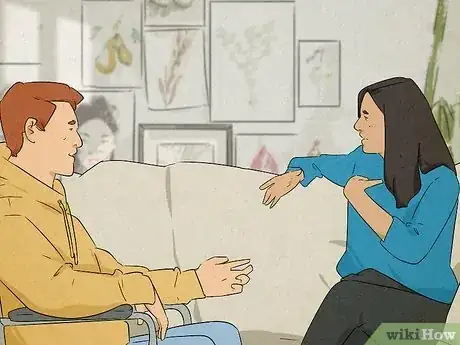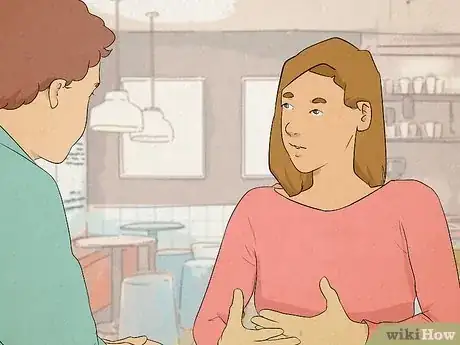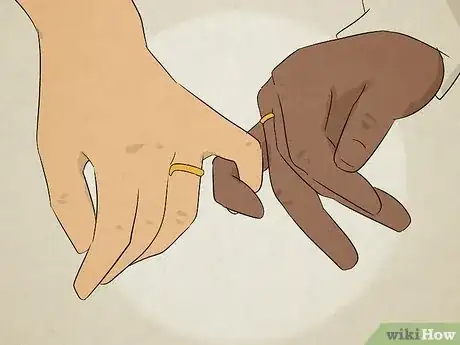This article was co-authored by Asa Don Brown, PhD, DNCCM, FAAETS and by wikiHow staff writer, Nihal Shetty. Dr. Asa Don Brown is a Clinical Psychologist with over 25 years of experience. He specializes in working with families, children, and couples, treating a variety of psychological disorders, trauma, and abuse. Dr. Brown has specialized in negotiation and profiling. He is also a prolific author having published three books and numerous articles in magazines, journals, and popular publications. Dr. Brown earned a BS in Theology and Religion with a minor in Marketing and an MS in Counseling with a specialization in Marriage and Family from The University of Great Falls. Furthermore, he received a PhD in Psychology with a specialization in Clinical Psychology from Capella University. He is also a candidate for a Masters of Liberal Arts through Harvard University. Dr. Brown is a Fellow of the American Academy of Experts in Traumatic Stress and a Diplomate for the National Center for Crisis Management and continues to serve a number of psychological and scientific boards.
There are 8 references cited in this article, which can be found at the bottom of the page.
This article has been viewed 7,178 times.
If you’re thinking about opening up your relationship, or starting an open relationship from scratch, you probably have a few questions. Open relationships are more common than people think, with estimates of around 3 to 7 percent of people in North America currently in one. People in open relationships report high levels of satisfaction in their relationships, and so if it’s something that you think you and your partner might be interested in, it might be worth talking about.[1] Here, we’ll walk you through what kinds of open relationships exist, their pros and cons, as well as tips on making open relationships work and explaining them to other people.
Steps
What are the pros and cons of an open relationship?
-
1Freedom is the major benefit of open relationships. If you feel like you are someone who has always felt confined and stifled by monogamy, an open relationship might be the right choice for you. Open relationships allow you and your partner to fulfill sexual needs you may not be able to get from one another, which can remove some of the pressure you might face in the bedroom.
- Some people begin relationships making it clear that they want an open arrangement; other couples decide to open up their relationships after some time. In either case, communication is key to prevent hurt feelings and resentment.
-
2Open relationships don’t necessarily have any negatives, but they aren’t for everyone. If you or your partner experience strong feelings of jealousy, have difficulties with communication, or cannot imagine your partner with someone else and feel positive about it, opening your relationship could seriously damage it.[3]
- It’s okay if you aren’t someone who is interested in a non-monogamous relationship—this doesn’t mean you are a worse or less open-minded person, just that you have different preferences.
- Remember that opening a relationship will not fix one that’s already on rocky ground. An open relationship is a test of communication and trust within a relationship—if these fundamentals aren’t already solid, an open relationship likely won’t work.
How to Make an Open Relationship Work
-
1Set clear boundaries before meeting other people. Boundaries are the single most important part of making an open relationship work, and both you and your primary partner need to have a clear understanding of what is acceptable in your arrangement. Some boundaries you might have include:[4]
- Not meeting other people for sex when you and your primary partner are not on good terms with each other.
- A limit to how many people you can sleep with each week or month.
- Checking in with each other before meeting someone else.
- What types of sex are acceptable, such as penetrative sex, BDSM, or other kinks.
- Making it clear to any new sexual partners that you’re in an open relationship.
- Not having sex with mutual friends or colleagues.
- Returning home every night.
-
2Talk about feelings of jealousy when they come up. Jealousy is a natural human emotion, and open relationships aren’t an exception. But it’s important to work through these feelings with your partner and to find ways to deal with them together.[5]
- For instance, you might find hearing the details of your partner’s encounter with someone else exciting, or they might make you upset. Both responses are normal, but if you do find yourself becoming upset, talk with your partner about why that might be the case, and how you can feel better about the situation.
- For example, you might say something like, “I feel sort of insecure when you spend time with someone else on the weekends. Do you think that we could save the weekend for ourselves, and you can meet other people on weekday nights?”
-
3Call a timeout if you need one. Sometimes open relationships can feel overwhelming, but by having a standing rule that both you and your partner can call a timeout on meeting new people for a while, you can work through whatever issues you may be dealing with.[6]
- If either you or your partner calls a timeout, avoid pressuring them to change their mind. This might only make feelings of insecurity worse—instead, accept their decision, and work on enjoying your time together more.
-
4Remember to practice safe sex. Being sexually active with multiple partners always comes with the risk of sexually transmitted infections, but you can mitigate this risk by using condoms, PrEP, and other forms of safe sex. Get tested frequently to make sure both you and any partners you have are staying safe.[7]
-
5See a couple’s therapist to help you navigate your feelings. Since open relationships require high quality communication in order to work best, seeking out professional help can help your relationship succeed. A couple’s therapist can help you and your partner broach issues that you might be uncomfortable with and bring you closer together.[8]
How to Bring Up an Open Relationship with Your Partner
-
1Find a private time to talk when you’re both calm. Something as big as opening up your relationship shouldn’t be brought up when you aren’t on good terms with your partner. Choose a time and place where you won’t feel rushed, like the privacy of your home, so that you can feel free to discuss some difficult topics in detail.
- Schedule some time for this conversation ahead of time with your partner by saying something like, “Hey, I love being with you and so grateful for our relationship. I’ve been thinking about us, and wanted to know if you would have some time tonight to talk about how things are going.”
-
2Tell your partner that an open relationship doesn’t mean you love them less. There is a lot of stigma against open relationships, and your partner might not take hearing that you want one well. Reassure them of your feelings and attraction to them, but be prepared—this conversation will change your relationship, and it could possibly end it.[9]
- For example, you might say something like, “I wanted to bring up with you the possibility of opening up our relationship. I love you now more than ever, so please don’t take this as a sign that I don’t. But I think we could both gain a lot by having some more sexual freedom in our relationship, if that’s something you’re interested in.”
- This conversation will be much easier if your partner has previously expressed interest in non-monogamy. They might have brought up topics like threesomes or been supportive of open relationships among their friends. If your partner comes from a more traditional background, there might be a lot more resistance.
- You can try to see how your partner might react to you bringing up open relationships ahead of time by asking them a more general question, like “I’ve been seeing people talk about open relationships a lot—what do you think of them?”
-
3Respect their decision, no matter what it is. If your partner says they aren’t willing to entertain the notion of an open relationship, or if they seem really uncomfortable about it, there is no point in pushing them into it. Those feelings will never go away. Though it will be difficult, you’ll have to make a choice about whether you want to stay in a monogamous relationship, or breakup and find a new partner.[10]
- If your partner says no to an open relationship, and you still want to be with them, reassure them that you understand their decision. Say something like, “I completely understand where you’re coming from—I love you, and I’m more than happy to keep our relationship exclusive.”
How to Explain an Open Relationship to Other People
-
1Be honest when responding to questions. Open relationships are still a hot topic, so you’ll probably run into some questions—both well-meaning and not. By being honest and confident in your responses, you can show people that open relationships are nothing to be ashamed of. Here are some questions you might face, as well as some ideas for how you might answer them:[11]
- “Isn’t it just an excuse to cheat?” "Any relationship can be selfish or greedy, not just open relationships. Trust and being honest with your partner are as important in open relationships as they are in closed ones, and breaking trust by crossing boundaries is not acceptable in an open relationship."
- “How can you have a relationship like that? I couldn’t do it.” "Open relationships definitely aren’t for everyone, but they work for some people. If you don’t think you could handle an open relationship, you’re probably right, but that doesn’t mean that others can’t."
- “Don’t you feel like you’re missing something by not being exclusive?” "Open relationships aren’t ‘watered-down’ relationships, and not being sexually exclusive with one person doesn’t mean that your relationship lacks any intimacy or connection."
-
2Emphasize the importance of your primary partnership. Because of the stigma surrounding open relationships, people (including new sexual partners) might think that you aren’t committed to your partner. Saying something like, “My partner is the most important person in my life,” or something along these lines, can help make it clear to others where your commitments lie.
-
3Know you have a right to privacy. You don’t have to answer anyone’s questions if you don’t want to, and you don’t need to feel pressured to disclose the status of your relationship. You and your partner should decide together who can know about your open relationship, whether that means sexual partners, close friends, or family.
References
- ↑ https://www.sciencedaily.com/releases/2018/06/180628151713.htm
- ↑ https://sexualbeing.org/blog/8-relationship-alternatives-to-monogamy/
- ↑ https://www.goodtherapy.org/blog/7-things-to-consider-before-opening-your-relationship-0502184
- ↑ https://www.womenshealthmag.com/relationships/a19908611/open-relationship-rules/
- ↑ https://www.womenshealthmag.com/relationships/a19908611/open-relationship-rules/
- ↑ https://www.endinghiv.org.nz/articles/culture/how-to-be-in-a-healthy-open-relationship/
- ↑ https://www.endinghiv.org.nz/articles/culture/how-to-be-in-a-healthy-open-relationship/
- ↑ https://www.goodtherapy.org/blog/So+Your+Partner+Wants+Open+Relationship
- ↑ https://thelatch.com.au/how-to-ask-your-partner-for-an-open-relationship/



